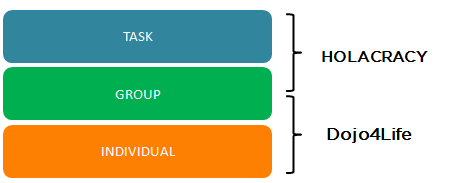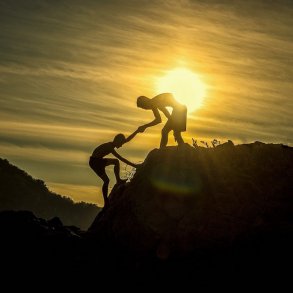Written by Nikyta Guleria and Graham Boyd and originally posted at Dojo4life
This is a story of how the ‘nice to have’ human aspects of the business are really the ‘need to have’. The story of how our non-profit, edgetalents, became a successful for-profit in a year. A story of how we re-invented the company, turning it into a deliberately developmental one(1). We blended traditional business methods with Holacracy, adult development from Laske, Kegan and Dojo4Life (2); and good old Art of Hosting methodologies. Having just read Frederic Laloux’s book, we believe our edge talents story may be useful to others re-inventing their organisations.
Nikyta: This is also my story. As a recent graduate, about how I went from needing safety and stability in titles, benefits and fixed job descriptions so that I could be productive, to getting all I needed from deeply open communication, participation, and personal growth at the workspace.
Graham: And it is also my story. As a P&G manager I was constantly thinking: “How can one of the oldest and best companies in the world waste so much of their human capital? Why are so many alienated, and at their most productive after hours doing their hobbies? There must be better, easier ways. Ways that enable far more output and develop human well-being without compromising either.” Leading the transformation of edge, I put into practice all I have learnt and developed over the past decade about how to re-invent an organisation. Especially what I have learnt about the strengths and shortcomings of different new ways of organising and working.
Nikyta: The edge that I joined in September 2013 was an international grant receiving foundation that provided talent to Social Businesses. Come December, it was all about to change. There was a need to transform the foundation that I joined, into a for-profit, whose products were capable of tackling all the unaddressed ‘HR’ problems of startup ecosystem.
Graham: I had been coaching the leadership for a year by then. Now came a mandate from the investor to transform to for-profit. So time to dive deeper in as strategy and transformation consultant … The first step was to dive back into our markets, and engage with as many stakeholders as possible. We gathered data from 180 + businesses, investors and start-up talent, across 5 countries
Nikyta: This was a tough journey from the start. It also developed all of us as people, and made the business successful. And we all grew a deeply trusting friendship with each other, from Graham as CEO through to me as the newest hire.
Graham: edge needed to make bigger and faster changes than most organisations can survive. Changes in the organizational structure, the clients that were targeted and the products that were delivered. It was clear that success would only be possible if we consciously developed each individual’s internal stability and our stability as a team.
We began by using Kegan’s Ongoing Regard – a structured way of giving feedback to the recipient on what was helpful. This led to th e implementation of peer to peer sparring methodologies, from the Dojo4Life Movement. (Inspired by Prof. Otto Laske’s Developmental Coaching framework).
e implementation of peer to peer sparring methodologies, from the Dojo4Life Movement. (Inspired by Prof. Otto Laske’s Developmental Coaching framework).
Nikyta: These tools acted like a catalyst, in helping us see how the interpersonal tensions that every business and team faces, needed to be embraced, rather than brushed under the carpet. For example, just as a bridge, you need both the tension and compression to give it strength.
 The next level of tensions we had to address were those that emerged inherently out of our titles and roles. For this, we brought in simplified Holacracy.
The next level of tensions we had to address were those that emerged inherently out of our titles and roles. For this, we brought in simplified Holacracy.
The deeper we went into the transformation, the more our inner complexity threw ship-sized spanners in the works. It was tough to not subconsciously sabotage myself and each other once in a while. Especially tough not to sabotage / scapegoat Graham! Clearly we needed more than Holacracy to process all our tensions!
Allow me to illustrate a small step that had big consequences on me during this new way of working.
As Manager of the India operations, I had to make sure our business was ‘out there’, and the easiest way to do this was usually through networking events. What was easy for some, used to drain a significant amount of my energy. When my role required me to be at these events more often, I found myself subconsciously identifying other tasks to attend to, and pushing myself to the point of mental exhaustion.
What I was able to identify through the Dojo4Life developmental sparring process was the reasoning behind why I was experiencing what I was. To my complete surprise, it boiled down to my needs of safety and contribution, and the “Big Assumptions” that created the fear-filled meaning for me as I started networking. ‘Cold’ leads and conversations at these events would spark an inner contradiction in me – the need to prevent any fear-inducing situation where any individual could judge me or what I represented (edge’s transition phase, in this case), and my need to be seen as someone in the team who is putting in their best, to help the business succeed. Two small “big assumptions” but a clear internal friction point. These elements that usually lead to burnouts, or even being fired.
There was no right or wrong in what I learnt about myself. It was simply the inner needs I held dearly, that I was not aware about, let alone anyone in the business. With the support of Graham’s operating system (2) I was able to succeed. To do well because I had these fears.
Acknowledging what was uncovered with everyone else in edge, a simple solution was devised. I was to go to these events with someone, or have introductory conversations prior to meeting people at the event – steps that helped prevent triggering my psychological immunity. Soon a task that I had dreaded became an enjoyable day out of office.
It struck me that developmental coaching within Graham’s approach wasn’t coaching. It was a way for us to work day by day, to understand what our assumptions of the world are, and how they enable or disable us, even in everyday activities. This helped create a business system that is able to tap into the core member’s roles, accountabilities, and interactions in such a way that it would either :
- ensure that tension points were not triggered;
- if & when triggered, there was a safe, open space to have a dialogue with those who understand where you come from;
- bring changes in the organisation structures and processes (and not the individual) so that we could be maximally productive, being as we were.
In no time I was able to absorb and relate to every new change that edge brought about, at the speed of change – within the business and within my role. This combination of different methods dealing with internal re-structuring, governance and personal development, helped boost my confidence in myself and the business.
Graham: In just 12 months, edge had transformed why it existed, how it worked, and what it sold. We became an example to others in the space to see employees as the foundation of Human Capital. Not just human resources that needed to be managed through surface offerings of promotions, increments, trainings etc. Our products, as well as internal operations, were now based on the understanding of where the natural energies of an individual truly lay, and how to create a structure and system that supports these individuals. The team that began this journey, had stayed intact, and was continuously willing to embrace cutting-edge plans and ideas. There was also a feeling of oneness never experienced before, backed by products that were now creating ‘real’ value for businesses. When the investor decided to change aim again, everyone said “but now I know what it’s like to work with passion, how can I go back to old ways of working?”
Nikyta and Graham: The deep reason for my commitment to edge was the connection that was created between my realization of my inner needs and the business being able to take those needs into account, in a way that led to even more productivity and not less.
What I thought were ‘nice to have’ aspects at a work space, were now a ‘need to have’. For the business to be able to outdo itself month after month, and for my personal development, with no compromises on either.
————————————————-
edge has now split into successfully run independent local entities, and I’m collaborating with Graham on bringing these innovative ways of working to many more small and growing businesses (2). Contact one of us if you want to know more about how to do this. We are based in the UK, Germany, India, and Kenya; with partners in Brazil and Colombia.
Footnotes:
- Robert Kegan, “Making Business Personal”, Harvard Business Review https://hbr.org/2014/04/making-business-personal
- Dojo4Life is a the human Operating System complementing Holacaracy. It blends 3 elements of coaching into a peer to peer approach, much like Art of Hosting does for facilitation. First, it starts with a simplification of the Inter-Developmental Coaching method of Otto Laske http://interdevelopmentals.org/; second, it uses elements of Positive Psychology from Seligman, and elements of change from Kegan; thirdly, it uses elements to help individuals “catch” themselves; and finally it embraces the requisite organisation approach of Jaques.




An excellent HBR article covering complementary aspects of what we’ve written above
https://hbr.org/2015/09/the-big-misconceptions-holding-holacracy-back